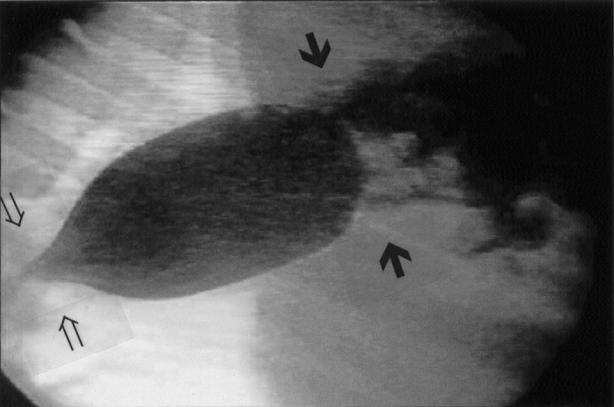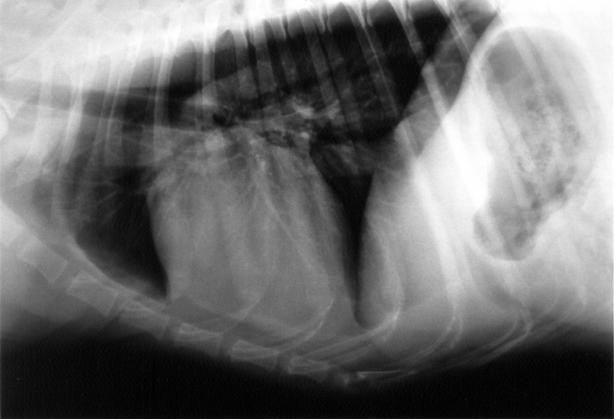Abstract
A 5-year-old, castrated male, golden retriever was presented with a history of regurgitation. An esophagram revealed normal peristalsis with failure of the lower esophageal sphincter to open, supporting the diagnosis of esophageal achalasia. Prior to surgery, the dog developed megaesophagus. Heller's esophagomyotomy resolved the clinical signs and the esophageal dilation.
A 5-year-old, castrated, 29.9 kg (65 lb), male golden retriever presented with a 10-day history of regurgitation and ptyalism. The patient primarily regurgitated solid food, with occasional regurgitation of water. Past medical history included idiopathic epilepsy diagnosed at 2 y of age, which was well controlled with phenobarbital (Phenobarbital; United Research Laboratories, Philadelphia, Pennsylvania, USA), 60 mg, PO, q12h. Prior to referral, the dog was treated with oral metoclopromide (Metoclopromide; Sidmark Laboratories, East Hanover, New Jersey, USA), 20 mg, PO, q8h, without improvement in clinical signs.
Physical examination revealed a thin dog with a 2 out of 5 body condition score. The dog was bright, alert, and responsive, with a normal rectal temperature, heart rate and respiratory rate. The results of a neurological examination were also normal. Results from a complete blood cell count, serum biochemical profile, and urinalysis did not indicate any metabolic abnormalities. Thoracic radiographs revealed a normal distal cervical and thoracic esophagus, as well as normal lung fields. Esophageal motility was evaluated with esophagography. Fluoroscopic studies after the administration of liquid barium sulfate (3 mL/kg body weight (BW)) followed by barium mixed with food revealed a normal pharyngeal phase of swallowing with normal primary and secondary esophageal peristaltic waves. There was, however, a failure of the lower esophageal sphincter to open (Figure 1a). Several diagnostic tests were done to determine the reason for the dysfunction of the esophageal sphincter. A normal serum-free T4 concentration (11.6 pmol/L; reference range, 1.03 to 25.0 pmol/L) ruled out a hypothyroid-associated peripheral neuropathy. Hypoadrenocorticism, another potential cause of esophageal dilation, was unlikely, given the normal laboratory finding; therefore, an adrenocorticotropic hormone (ACTH) stimulation test was not done. A serum acetylcholine receptor antibody titer (0.01 nmol/L; reference, range < 0.06 nmol/L) was normal, making myasthenia gravis improbable. Electrodiagnostic tests, such as electromyography and nerve conduction velocities, were not performed due to the lack of evidence of generalized muscle atrophy or weakness. The esophagus was visualized directly with a video endoscope (Olympus America, Lake Success, New York, USA) to rule out the presence of gross intraluminal abnormalities in the area of the gastroesophageal junction (GEJ); the esophageal mucosa and GEJ were normal. Endoscopically obtained mucosal biopsies of the esophagus were normal. A gastrostomy tube (Bard Urological Division, Covington, Georgia, USA) was placed during the endoscopic procedure for nutritional support. The patient was discharged with instruction on standard tube care and to feed slurry of an energy dense pediatric diet (Hill's P/d; Topeka, Kansas, USA) through the gastrostomy tube.

Figure 1a. A pre-operative esophagram revealing a strong esophageal contraction pushing the ingesta (open arrows) towards the lower esophageal sphincter, which failed to relax and open (closed arrows).
The demonstration of normal esophageal motility with failure of the lower esophageal sphincter to open was consistent with diagnosis of esophageal achalasia. Palliative treatment with esophagomyotomy was recommended to facilitate the passage of ingesta through the lower esophageal sphincter and decrease regurgitation.
The dog was readmitted 1 wk later for surgery. Prior to surgical intervention, thoracic radiographs were taken to reevaluate the esophagus. These radiographs revealed a generalized gas distended esophagus and mild alveolar pattern that was consistent with postural lung collapse due to recumbency (Figure 1b). The dog underwent a distal esophagomyotomy (modified Heller's procedure), as previously described (1). The patient was positioned in dorsal recumbency and a midline abdominal incision was made extending from the xiphoid process to the umbilicus. Babcock forceps were used to retract the stomach, permitting visualization of the distal part of the esophagus, the region of the lower esophageal sphincter, and the cardia of the stomach. The gross appearance of these structures was normal. A longitudinal incision was made on the ventral aspect of the gastroesophageal junction through the tunica serosa and tunic muscularis, extending from the distal 2 cm of the esophagus to the proximal 2 cm of the stomach. The esophageal and the gastric mucosa bulged through the completed incision. The abdomen was closed in a routine manner. Recovery from surgery was uneventful. The dog was discharged 4 d postoperatively with instructions for his owners to feed small amounts of food orally with the dog's forelimbs in an elevated position.

Figure 1b. A right lateral thoracic radiograph taken immediately pre-operatively demonstrating generalized gas distention of the esophagus (arrows).
The dog was reevaluated 11 d postoperatively. Thoracic radiographs showed resolution of generalized esophageal dilation (Figure 2). At this time, the dog was receiving his full caloric intake, PO, in the normal standing position, and with no evidence of regurgitation. Three months postoperatively the dog continued to do well. At that time, an esophagram showed normal esophageal motility with normal esophageal emptying. Insignificant esophageal reflux was the only complication noted resulting from the surgery.

Figure 2. A right lateral thoracic radiograph 11 d postoperatively demonstrating complete resolution of the esophageal dilation.
Esophageal achalasia is a disease of unknown etiology that interferes with esophageal emptying. The term “achalasia” refers to a failure to relax, the cardinal feature of this disorder (2). The normal physiologic function of the gastroesophageal sphincter (GES) is to relax and open during swallowing. The GES is a physiologic rather than an anatomic sphincter, because it does not consist of a specialized large mass of muscle. In dogs, the GES consists of an outer layer of longitudinal striated muscle fibers with an inner layer of smooth muscle (3). Fibers in the vagus nerve mediate relaxation of the GES, seconds before the bolus reaches the sphincter, allowing the passage of food into the stomach. The GES then immediately contracts, preventing reflux of the gastric contents into the esophagus (3,4). Esophageal achalasia is the most commonly recognized motor disorder of the esophagus in humans (2). Lesions have been detected in both muscle and nerve; however, a neuronal lesion is thought to be of primary importance (2). Degenerative changes, including fragmentation and dissolution of the nuclear material in the vagal dorsal motor nuclei, have been proposed. Physiologic and anatomic studies have confirmed the presence of denervation of the smooth muscle segment of the esophagus. A loss of ganglionic cells in the region of the GES, predominantly of inhibitory neurons, would result in an increased basal pressure and poor relaxation of the GES (2). The clinical signs include dysphagia, regurgitation, weight loss, chest pain, and aspiration pneumonia (2,5). The diagnosis of lower esophageal achalasia is made by fluoroscopic evaluation of the esophagus. Manometric determination of elevated pressures within the lower esophageal sphincter further supports the diagnosis of esophageal achalasia and is particularly important when radiographs are normal or inconclusive (2).
In the 1970s and 1980s, the syndrome of esophageal “achalasia” was described in the veterinary literature. A dog with esophageal achalasia and megaesophagus was treated with esophagomyotomy; however, the esophageal motility did not return and as a result, elevated feeding had to be continued to control clinical signs (6). Ryer and Ryer (7) described esophageal dilation in a dog in which, on esophagram, there was no evidence of esophageal contractions (7). Similarly, Clifford (8) reported a series of 3 dogs with generalized esophageal dilation with a narrowed caudal portion of the esophagus (8).
The dog in this report satisfied most of the criteria used to diagnose esophageal achalasia in humans. As in humans with achalasia, this dog's esophagram showed esophageal contraction against a lower esophageal sphincter, which failed to relax and open. Retrograde movement of esophageal contents was observed repeatedly. Unlike the previous case reports, on initial evaluation, the dog's esophageal motility was normal and the esophageal dilation was not present. At the time of surgery, however, esophageal dilation was noticed. This dilation may reflect decompensation of the esophagus, a phenomenon described in some humans with esophageal achalasia (5,9). Lastly, esophagomyotomy in humans with esophageal achalasia improves clinical signs as was seen in the dog in this case report.
In humans, palliative therapy for esophageal achalasia includes pharmacotherapy with calcium channel blockers, Botulinum toxin injection, pneumatic dilation, esophagomyotomy, myotomy, and fundoplication (2,5). Indications for surgical intervention in humans are the presence of regurgitation, or the development of esophageal dilation (2,5).
To the authors knowledge, this is the first case report of a dog with true esophageal achalasia without esophageal motility disorder. Unfortunately, the definitive cause for this dog's acquired lower esophageal achalasia was not determined. Similarly, the etiology of primary lower esophageal achalasia in humans has never been identified. While achalasia of the upper esophageal sphincter (cricopharyngeal achalasia) has been well described as a congenital condition in dogs, lower esophageal achalasia appears to be a rarely acquired condition in dogs. Although manometry was not performed, the clinical signs, age of onset, radiographic evaluation, and complete response to the esophagomyotomy without the necessity of continued elevated feeding provide evidence that the dog in this report had acquired lower esophageal achalasia.
Footnotes
Acknowledgments
The authors thank Dr. Nolie K. Parnell for her contribution and suggestions. CVJ
Address all correspondence and reprints requests to Dr. Boria.
References
- 1.Fingeroth JM. Surgical disease of the esophagus. In: Slatter ed. Textbook of Small Animal Surgery. 2nd ed. vol 1. Philadelphia: WB Saunders, 1993:534–561.
- 2.Clouse RE, Diamant NE. Motor physiology and motor disorder of the esophagus. In: Feldman M, Scharschmidt BF, Sleisenger M, eds. Gastrointestinal and Liver Disease: Pathophysiology/Diagnosis/ Management. 6th ed. vol 1. Philadelphia: WB Saunders, 1998: 467–493.
- 3.Strombeck DR, Guilford WG. Pharynx and esophagus: Normal structure and fuction. In: Guilford WG, Center SA, Strombeck DR, Williams DA, Mayer DJ, eds. Small Animal Gastroenterology. 3rd ed. Philadelphia: WB Saunders, 1996:202–209.
- 4.Guyton A, Hall J. Textbook of Medical Physiology. 9th ed. Philadelphia: WB Saunders, 1996:803–813.
- 5.Donahue P, Schlesinger PK, Bombeck CT, Samuelson S, Nyhus LM. Achalasia of the esophagus. Treatment controversies and the method of choice. Ann Surg 1986;208:505–511. [DOI] [PMC free article] [PubMed]
- 6.Boothe Jr. HW. Acquired achalasia (megaesophagus) in a dog: clinical features and response to therapy. J Am Vet Med Assoc 1978;173:756–758. [PubMed]
- 7. Ryer KA, Ryer J. Acquired achalasia: a case report. Vet Med Small Anim Clin 1980;75:1703–1704. [PubMed]
- 8.Clifford DH, Waddell ED, Patterson DR, Wilson CF, Thompson HL. Management of esophageal achalasia in Miniature Schnauzers. J Am Vet Med Assoc 1972;161:1012–1021. [PubMed]
- 9.Schneider JH, Peters JH, Kirkman E, Bremner CG, DeMeester TR. Are the motility abnormalities of achalasia reversible? An experimental outflow obstruction in the feline model. Surgery 1999;125: 498–503. [PubMed]
- 10.Strombeck DR, Guilford WG. Diseases of swallowing. In: Guilford WG, Center SA, Strombeck DR, Williams DA, Mayer DJ, eds. Small Animal Gastroenterology. 3rd ed. Philadelphia: WB Saunders 1996:211–235.


